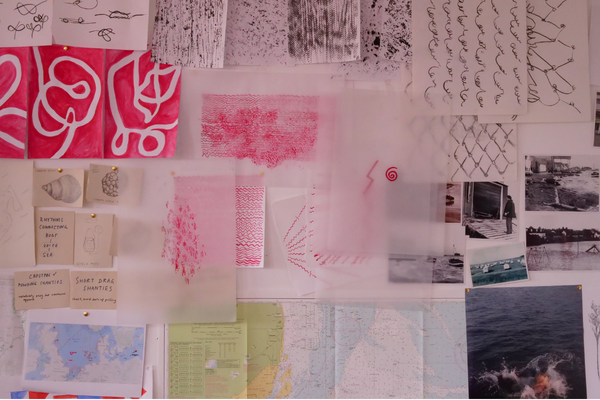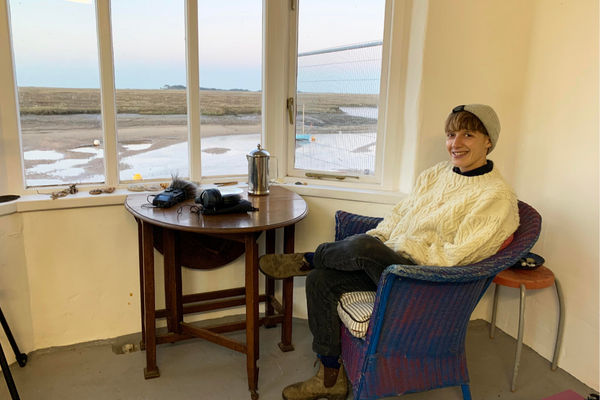Isabella Martin is an artist who explores the friction between us and our environment and the ways we both shape and are shaped by our surroundings. She shares her experience of her North Sea Residency in Norfolk.
There’s more sea and sky than land on the North Norfolk coast. On a clear day, you can stand at the harbour entrance and see the largest wind farm in the world, Hornsea, to the north, the ones at Sheringham Shoals to the south. If it’s a big low tide, sand stretches as far as the eye can see. A few hours later, the scene is transformed, the North Sea laps at your feet, the oyster catchers leave and are replaced with fishing boats bringing their whelk catch in on the incoming tide.
I’m an artist from Norfolk and I work site-specifically and across media, places and collaborative encounters informing how I work and what I make. For the residency I chose to work in Wells-Next-The-Sea. I’ve seen the town change dramatically during my lifetime, and I was excited to explore these changes in collaboration with local communities. My focus was on the shifting rhythms of the town, the flux in different industries from fish to wind, whelks to malt and back again. I was intrigued to explore what Roger Arguile[2] describes as the long pattern of opportunity and reversal in the town, from the perspective of those who live and work there.
“Way haul away, we’re bound for better weather”[3]
I framed the residency in the context of my ongoing research into sea shanties and their rhythms - call-and-response songs sung by sailors to keep time with each other while working at sea. I’ve long been intrigued by the practical function of shanties, and the way their form echoes the seas’ movement. Song lyrics date their origin, longing for sea while on land, longing for land whilst at sea, sweethearts, shipwrecks, late pay packets and blowing it all on whisky. I began to wonder what the modern equivalent would be, and this question shaped my approach while in residence.
"You can’t map them, they change all the time. People are always getting lost or drowned.”[4]
I worked in Wells in several phases, starting with a studio at Wells Community Hospital and ending up in a studio in a converted Whelk Shed looking over the marshes and out to sea. I met with everyone from Wells primary school to the Nelson friendship group, from a nursing home singing class to the local coastguard. These encounters sharpened my focus, we talked about the sea and the future, energy, how we use it, the cost of living, and the increase of second homes in the town (up to 40% of residential homes). I experimented with different strategies for describing, remembering and imagining the coast; sang sea shanties, drew objects washed in on the high tide, drank tea and listened. I met and recorded the Sheringham Shantymen in concert and rehearsal, learning about the evolution of shanties, what singing these songs means for the retired fisherman and sailors in the choir and we wondered together - will these songs be forgotten?
Drawing objects washed in on the high tide with the local art group
“There’s still good fishing here"[5]
Fishing was and is a big industry in Wells. Whelks used to be sent to London, now they’re sent overseas while crabs are prepared in town for the hotels. The Port of Wells Lobster Hatchery on the quayside is a new initiative focused on marine conservation, catching and breeding lobsters which are then released back into the wild, protecting and increasing local fishing stock.

Isabella's studio wall, including sketches, archival photos and maps
Derek, a retired coastguard, used to help his dad shake the whelks out the nets while fishing at sea, now one of the biggest fishing boats in town is owned by Derek’s nephew, Andy. Andy paid for the boat through compensation from the wind turbine companies for not fishing in the turbines’ restricted zones. The town'sfortunes go up and down. Opinions on the offshore wind farms vary. Back in 2021 the companies stopped needing a local base for maintenance, moving operations to Great Yarmouth, leaving a new marina, but taking jobs south.
“It’s like there’s land out there now”[6]
In the studio I collected everything, new and archival, listening back, drawing and filming. I recorded the sea and tried to sing its rhythms with the year 4 class at Wells Primary. I’m now working on pulling it all together into a series of works, guided by another question in continuation of my first. What are the working rhythms of this coast now? What would a song reflecting the ebb and flow of life here sound like? What form would it take? This area is defined by perpetual change, on scales from the minute to the grand, the fleeting to the permanent. Some of the biggest tides in the country change the view daily. Where once was a bingo hall, now stands luxury flats. The sandbanks shift constantly and the afternoon sky is filled with the sound of pink footed geese in winter. The turbines out at sea blink red at night. What was sea looks like land, what is land may soon be sea. How do we keep track?
To see more of Isabella's work visit: https://isabellarosemartin.com/Visual-Artist and Instagram: isabella.r.martin
[1] Lucy, year 4, Wells Primary School
[2] Wells in Pictures: Then and Now - Roger Arguile, 2021
[3] Haul Away Joe - Short-drag shanty
[4] Pam, Wells Wanderers
[5] Derek, retired coastguard
[6] Fiona, Wells Wanderers


